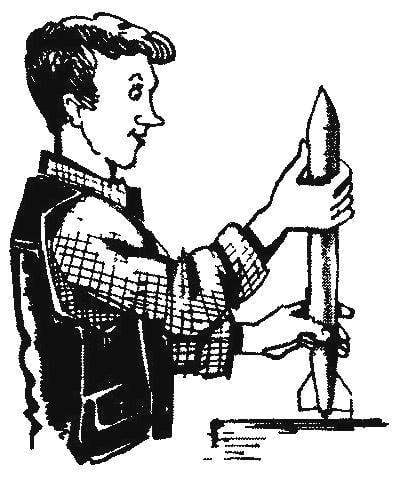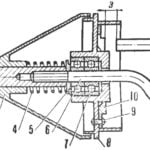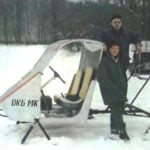
 In 1966, the Commission on space models of the International aeronautical Federation (FAI) has developed a code of sport in which raketoplana divided into four classes and assigned a so-called “bird” names “Sparrow”, “swift”, “eagle” and “Condor”. On the amended in 1975 and 1989 the FAI code partition models raketoplana into categories and classes depending on the total impulse of the engine and the starting mass was clarified requirements for each category, classes are five, and since 2001 to six. Today we will talk about the category of raketoplana S4 — models of gliders with the accelerator Category is subdivided into six classes the Most popular class S4A — promised.
In 1966, the Commission on space models of the International aeronautical Federation (FAI) has developed a code of sport in which raketoplana divided into four classes and assigned a so-called “bird” names “Sparrow”, “swift”, “eagle” and “Condor”. On the amended in 1975 and 1989 the FAI code partition models raketoplana into categories and classes depending on the total impulse of the engine and the starting mass was clarified requirements for each category, classes are five, and since 2001 to six. Today we will talk about the category of raketoplana S4 — models of gliders with the accelerator Category is subdivided into six classes the Most popular class S4A — promised.
Technical data requirements sports “shells” such minimum mass of 18 g, the maximum is 60 g. the Momentum of the engine — 2,5 h, the maximum flight time in a round is 3 minutes. In flight, the engine or its container must be separated from the model and land on the ribbon (smallest 25×300 mm) or a parachute with an area of more than 4 DM2. If this condition is not met, the flight is considered non -.
Since the inception of the models raketoplana this category was always distinguished by an abundance of schemes and designs. It has been a continuous search of original technical solutions and there is a place for creativity of the Modeler-designer.
Speaking of models raketoplana S4, it is possible to allocate three main schemes for which the building today sports “shells” in this category. The first model airplane raketoplana scheme, similar in appearance to the plane. The influence of aviation. Time needed for sustainable planning, it is necessary to build the model according to the classical scheme of the aircraft.
I must admit that today such a scheme aircraft almost does not apply. The main reason — high probability of zero marks for the start, which often judges give models that use aerodynamic lift at this stage of the flight.
“The rocketeer” persistently sought the path of perfection takeoff characteristics of their raketoplana. So, in 1972, A. Gavrilov (Krasnozavodsk) developed a model rotary wing along the fuselage. Modelist from Elektrostal With Morozov offered with a folding wing to center consoles. For this wing for takeoff was given in the tail part, performing the role of a stabilizer After firing the lifting charge MRD it moved forward and the model began to plan.
In 1982 the all-Union competitions were presented the original model of the rocket plane, developed by the Moscow sportsmen under the guidance of coach Vladimir Minakov In this structure, lurks the ideas of the above modelers is a folding console and rotary wing this scheme rocket glider, so-called “Moscow”, today widely used as a sports “projectile”. Folded (during takeoff) rocket resembles an ordinary rocket — wing is along the fuselage After shooting mrad (at an altitude of about 200 m) wing with rubber bands, turns, and reveals its “ears” (console) — and the model becomes a conventional glider. This scheme rocket gliders today preferred by most athletes modelers Another group of raketoplana make up the aircraft, made under the scheme “flying wing” the Author and developer of its child is the teacher of the aerospace club “Union” In Ukrainians. Hence the name — “khokhlovskiy” First in flight, a model rocket plane was demonstrated 15 years ago the Scheme was unusual, but interesting It will satisfy all technical requirements in this category have made a vertical takeoff (with inclination up to 30° from the vertical), sustainably planned, had a small mass planning part and thus a small load on the wing Athletes with such models has performed at many competitions there have Been successes, there were also failures, But the work continued, the designers improved their sporting “weapons.” So, from the wing of foam came to mosaic the frame, thus reducing flight weight and increasing rigidity.
Raketoplana this design of a container-type Glider “flying wing” — folding, is placed in the container (rocket) for take-off. This gives you the opportunity to run it at high altitude the disadvantages I would mention the difficulty of observing a model and not always sustainable planning.
With models of this scheme was performed at the 16th world championship “rocket” Belarus and Japan. The success of Belarusian athletes first winner of the world championship was In Minkevich and third — And Lipa.
We offer model rocket modeling class Ѕ4А container type is made according to the scheme “flying wing”, consists of the glider container, with its safe landing.
“Flying wing” sweep 14° has a span of 740 mm and a transverse V = 6° Profile — convexo-concave “göttingen-361” with the changing curvature of the middle line S-shape profile required to ensure stability is achieved by deflection of a hinged flap Angle deflection is selected by the adjustment process starts.

Model rocket modeling class S4A-type “flying wing”:
1 — fairing, 2 — band-isolator, 3 — model container carrier, 4 — thread suspension, 5 — stabilizer, 6 — MRD, 7 MRD latch, 8 — pylon wing, 9 — weights, 10 — gum disclosing wing 11 — the hook 12 — gum return, 13 — filament fastening gum, 14 — wing 15 — the leading edge, 16 — end of the flap, 17 — trailing edge flaps, 18 — rib, 19 is a longitudinal, 20 — ending
The wing — folding, the “broken” side member (19) along a scale Design of it — composing, consists of two halves, each of which is manufactured as follows First, assemble the frame consisting of the front edge of the wing (15) section 8×4 mm, the rear edge (17) of the flap (8×1,5mm), spar (4×3 mm), ribs (18) with a thickness of 2 mm and the fins (20) with a width of 10 mm.
Glued the frame is lightly sanded, achieving the desired profile Then sharpened knife cut along the side rail separating the flaps and the main part of the wing One flap (limit) with a length of 130 mm swivel attached using Mylar film to the spar at an angle of about 11°. It turns out the S-shaped profile on the end portion of the halves of the wing (section a-a) the Second (tail) of the flap with a length of 247 mm is also pivotally attached to a Mylar film with a width of 6 mm to the spar Make it so Both the pre-cut part is folded the lower planes and is glued to end surfaces of the spars Mylar tape That must be done especially carefully it is necessary to keep the curvature of the profile and make it the same on both halves of the wing.
In the leading edge in three places at a distance of 80, 225 and 320 mm from the pylon fixed three loops of rubber bands (12) with a length of 12 mm, loose ends are fitted inside the wing between the paired ribs pass Through the loops cuts Kevlar strands (13), the ends of which are glued into force of the ribs of the flaps Thus a simple mechanism for the return of the flaps in the working (planning) regulations.
Both halves of the wing of the hang glider metallic PET films with a thickness of 5 µm At the leading edge of the wing is fastened on top of the two hooks (11) for elastic return of the Half wing pivotally connected to the pylon, consisting of two Linden bars top and bottom Then plastic of 0.5 mm thickness, cut three records, two wide — size 30×10 mm and a narrow — 30×6 mm wide plates with one end of the drill 10 holes with a diameter of 0.6 mm, and narrow — both sides of the plate and Then connect together with a thread made of Kevlar, threading it through the holes, the resulting joint is glued with narrow plate to the underside of the upper element of the pole and attach the bottom element.
To the lower surfaces of the wing halves glue the free ends of wide plates. In this case, the wing sweep is given about 14° and the transverse angle of the “V” should be about 6° adjustment of the latter is carried out by gluing strips of paper to the side of the pylon or to the ends of the root ribs At the ribs at a distance of 15 mm from the front edge, make one hole with a diameter of 3 mm that insert lead weights to ensure the necessary alignment of the model glider, the Center of gravity of this rocket plane is at a distance of 60 mm from the leading edge of the pylon Mass model 18 g.
Container rocket — tube, glued paper (Delineator) on the mandrel of 35 mm diameter lower part on a length of 82 mm — cone attached To it three stabilizer cut balsa strips with a thickness of 0.8 mm of Their side surface is reinforced with a PET film on glue BF-2 For better bonding of the film to the balsa, the stabilizer is clamped between the metal plates and kept in a heated state for about an hour.
Next, connect the two parts of the container with the frame width of 6 mm and inside insert a paper tube with a diameter of 10.5 mm, in which is placed a MRD From the unplanned ejection it is fixed with a wire limiter, mounted on the conical part.
Fairing ogive shape vyklevyvajut on the mandrel of the five paper petals After drying, it was treated with sandpaper and varnish, then glued the splice sleeve of foam the Length of its boarding skirt — 20 mm and it fixed the elastic damper And the other, free end is bonded through a section of thread on top of the body of the carrier To the shock absorber attach the brake band sizes 400×45 mm.
The model preparation for the start are in the following order Install the engine in carrier rocket and snapped the latch on Top of the container is filled talc and install the wad It may be of cotton wool or foam (cylinder with a diameter 33 — 34 mm) Flaps of each half of the wing bends towards the front part thereof so that their lower surfaces in contact Then half turn again (every 90°), bending towards each other. In cross section it turns out the shape close to the rectangle, with dimensions 32×16 mm like this formed a box put into the container. Install the top fairing, after having put the brake band carrier Launch weight of about 33 g. model
Model takes off from the start of the pyramid Via a 3.5 — 4 at an altitude of 200 — 230 m works lifting charge MRD, which resets the fairing and pushes the glider “flying wing” Under the action of elastic return are disclosed halves of the wing and folded the items the Model makes planning a flight, and the container with MRD lands on the brake band.
V. ROZHKOV



